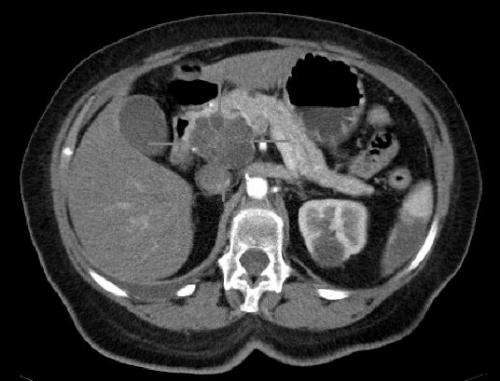
A DNA mutation that occurs frequently in the development of many pancreatic tumors appears to make these cancers vulnerable to an existing type of drug known as PARP inhibitors, according to a new study from scientists in the Perelman School of Medicine at the University of Pennsylvania.
The discovery, published in Science Advances, centers on a gene called MYBBP1A. Studies suggest that as many as two-thirds of patient cases of the most common type of pancreatic tumor have the deletion of one copy of this gene in the tumor cells. The Penn Medicine scientists found that while this deletion appears to contribute to tumor growth, the loss of the remaining copy of MYBBP1A in the tumor cells has the opposite effect, drastically reducing cell growth.
The team demonstrated, with experiments in pancreatic cancer cells and in mouse models, that they could exploit this vulnerability with certain members of an existing class of drugs called PARP1 inhibitors, which have the effect of inactivating the MYBBP1A protein when its levels are already low in cells. PARP1 inhibitors at present are mostly used to treat ovarian and breast cancers.
“A certain type of DNA deletion occurs frequently in pancreatic cancer, and we found in cell and animal tests that this DNA deletion makes these cancers selectively susceptible to existing drugs,” said Kenneth Zaret, Ph.D., a professor of Cell and Developmental Biology. “This is an exciting finding because there are no highly effective treatments for pancreatic cancer at present; moreover, this approach in principle could be used to find new treatments for other cancers that feature DNA deletions.”
The American Cancer Society estimates that nearly 60,000 people in the United States are diagnosed with pancreatic cancers each year, and nearly 50,000 people die of these cancers. The cure rate for pancreatic cancers is very low, largely because these cancers tend to be detected only in late stages when they have begun to spread in the body and are relatively resistant to chemotherapies and other treatments. Better therapeutic approaches to pancreatic cancers are desperately needed.
The most common form of pancreatic cancer, pancreatic ductal adenocarcinoma or PDAC, often features the partial deletion of one copy of chromosome 17. Human cells have 22 pairs of chromosomes plus the X and Y sex chromosomes. The loss of a portion of one copy of chromosome 17 in PDAC means that many genes located on that chromosome have only one remaining copy, so that the levels of the proteins these genes encode are reduced. This ends up boosting the growth of affected cancer cells, in part because one of the affected proteins is the tumor suppressor P53, which normally works as a powerful failsafe switch protecting against excessive cell division.
Antony Hsieh, Ph.D., an American College of Gastroenterology postdoctoral fellow in the Zaret laboratory during the study, wondered if the loss of other genes in these chromosome 17 deletions might make PDAC cells vulnerable in ways that future or existing drugs could exploit. He eventually zeroed in on MYBBP1A.
Hsieh and colleagues found that the loss of one copy of MYBBP1A, in PDAC cells with chromosome 17 deletions, somehow made the cells more cancerous, and thus added to the pro-growth effect of the partial loss of P53. On the other hand, the scientists found that de-activating the remaining copy of MYBBP1A, using genetic engineering techniques, effectively slammed the brakes on PDAC cells’ cancerous growth.
The scientists also found, from reviewing the biology literature and conducting their own experiments, that MYBBP1A proteins work on DNA in the nucleus of cells to promote the activity of growth genes, and in this role interact closely with proteins called PARP1 proteins. This hinted at a therapeutic opportunity, because researchers recently developed a class of cancer drugs called PARP1 inhibitors.
PARP1 inhibitors are approved for treating breast and ovarian cancers, and their mechanisms of action are mostly unrelated to MYBBP1A. However, some PARP1 inhibitors appear to work in part by trapping PARP1 proteins on coiled DNA in the cell nucleus. As the Penn Medicine team found, the PARP1 inhibitors that trap PARP1 in this way—namely the drugs olaparib and niraparib—eject the residual amount of MYBBP1A protein from the chromosomes, disrupting its growth-promoting function in the cell nucleus. In cells that have two working copies of the MYBBP1A gene and ample supplies of the MYBBP1A protein, the drugs appear to have no effect; but in PDAC cells that have lost one copy of MYBBP1A, these drugs have a growth-stopping impact like the full knockout of the MYBBP1A gene.
The team demonstrated this in lab dish experiments with PDAC cells, and showed that in a mouse transplanted with human PDAC cellsthat lack one copy of MYBBP1A, treating the mice with olaparib made the tumors much smaller than those in transplanted, untreated mice.
The results suggest that olaparib and niraparib might have a substantial benefit in the many thousands of patients whose pancreatic tumor cells have just one copy of MYBBP1A.
“We hope that these findings will encourage others to look at the loss of genetic material in cancers as an opportunity for developing new strategies against these cancers,” Hsieh said.
Zaret and colleagues now are working with other researchers at Penn Medicine to speed the development of their PARP1 inhibitor strategy with further preclinical experiments and one day, hopefully, clinical trials of PARP1 inhibitors in selected pancreatic cancer patients.
Source: Read Full Article






